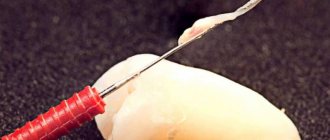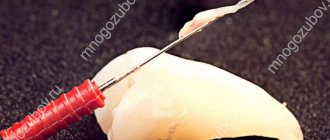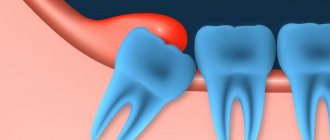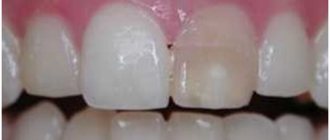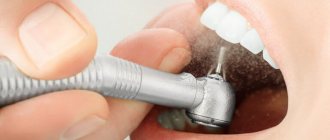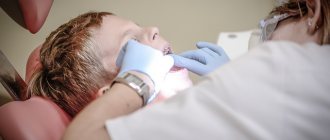Depulpation is a complex dental procedure that is not always successfully performed even in a clinic, not to mention nerve removal at home. The procedure is used in rare cases, for example, in cases of deep damage to dentin by carious processes or inflammation of the soft tissues of the tooth. The nerve endings are located in the pulp, which has a fibrous, loose structure. It is in this area that there is a nerve and a network of intertwined blood vessels through which nutrition is carried out.
After removal of the nerve, the tooth becomes more vulnerable to infectious pathogens. Gradually it darkens and loses its original strength characteristics. For this reason, before proceeding with depulpation, you need to make sure that this procedure is really necessary.
Indications for the procedure
Let's consider the main list of indications for the operation:
- Deep caries. Dentists advise patients to visit the clinic at least once every 6 months in order to identify and treat caries in the early stages of development. When only the enamel is affected, in 90% of cases it is possible to preserve the nerve endings of the tooth. The carious cavity can grow over several months and reach the dentin and pulp. In the latter case, a procedure to remove the nerve cannot be avoided.
- Unsuccessful dental treatment in the past. When removing tooth tissue damaged by caries, the doctor may accidentally open the pulp chamber. In this case, it will be important to remove the nerve to prevent the development of pulpitis under the filling. Amputation in this case can be complete or partial.
- The need for prosthetics. Typically, to restore the integrity of the row, prostheses are used that are attached to supporting units. The installation technology of most permanent structures involves depulping the elements that are considered as support. The procedure is necessarily carried out for teeth that are located at an angle.
- Serious mechanical damage to tooth tissue. Among the consequences of injuries are deep chips that affect the nerve endings of the teeth. In such cases, the damaged unit can rarely be saved, especially if we are talking about the front teeth. If the extreme molars are injured, then only partial depulpation is possible.
One of the main signs of incipient pulpitis is acute pain in the tooth of a vague nature. In rare cases, the disease becomes chronic and does not manifest itself with characteristic clinical signs. Only a dentist can accurately determine the presence of pulpitis using a thorough visual examination and temperature tests. If the doctor insists on depulpation, then you should not refuse the operation.
Symptoms requiring nerve removal
At home, several tests will help determine whether the tooth nerve needs to be removed. The first symptom is prolonged toothache, which intensifies when eating or turning the head. The intensity of the symptom increases at night, when the person assumes a horizontal position. People with pulpitis find it difficult to sleep without painkillers.
At home, you can do a cold test to determine pulpitis. To do this, cool a cotton ball in the freezer and touch it to several teeth located in the painful area. Typically, the affected unit does not react to cold immediately, but over time.
Aching pain may also indicate the need to visit a doctor. In this case, unpleasant signs appear only under the influence of various irritants - heat, cold, acids. Discomfort persists for some time after eliminating the irritating factor.
Symptoms of the lesion
The cause of the formation of a pathological process can be carious lesions, inflammation of soft tissues, or mechanical damage to the teeth. The main symptoms include severe aching pain that can radiate to the temporal tissue. You may experience bad breath. The painful area may react acutely to hot and cold foods. With the development of the pathological process, swelling, inflammation of the pulp chamber, and the formation of pus may be observed over the course of several days.
Many patients often wonder whether the nerve in a tooth can die on its own. Yes, maybe, if the destructive process has gone far enough. The main symptom will be a sudden cessation of pain. However, without timely dental intervention, the infection can spread further and affect the trigeminal nerve, leading to trigeminal neuralgia. The consequence will be impaired facial expressions, facial distortion and other anomalies.
Preparation before home depulpation
At home, you can kill the nerve of the tooth or reduce its sensitivity. In the first case, you will have to destroy the crown part of the tooth to get to the problem area.
Before suppressing the sensitivity of the structure, the following preparatory measures are performed:
- Decide whether it is necessary to kill the dental nerve or reduce its susceptibility to external irritants. The method of relief will depend on the intensity of the pain and the qualifications of the person who will carry out emergency measures.
- Treatment of the oral cavity with antiseptics.
- Cleaning the canals with a needle. It is preheated over a fire and treated with disinfectants, for example, Miramistin or Chlorophyllipt.
- Repeated antiseptic treatment of the mouth.
Why is nerve removal performed?
Long-term progressive pulpitis can ultimately lead to psychological disorders. This is due to the fact that a person constantly has to endure intense pain. Other complications of untimely intervention include:
- flux;
- osteomyelitis;
- periodontitis;
- dental granuloma;
- tooth loss.
Periodontitis is one of the dangerous complications of pulpitis
If the tooth has collapsed under the crown, the corrective device is removed and the element underneath is healed. The material of the prosthesis or crowns has better thermal conductivity than dentin and enamel. For this reason, severe cramps may occur when eating cold or hot food.
Stages of treatment
Most of the operations, the main task of which is to heal the inflamed pulp, can be divided into a list of conditional stages:
- Excision of dental tissue.
- Extraction of the neurovascular bundle itself.
- Channel cleaning.
- Filling.
The question of how pulpitis is treated in 2 visits with the removal of teeth and nerves can clearly be answered by any more or less qualified dental specialist. However, not everyone, even experienced doctors, had to deal with the most severe forms of this disease. It is not difficult to guess that the key to the success of the entire therapy as a whole is a visit to a specialized specialist who knows how to handle modern equipment and the advanced range of today’s pharmacological drugs. Such professionals, of course, include dental staff.
Suppression of nervous sensitivity at home
In life, there are often situations when a tooth hurts, and it is not possible to see a doctor in the near future. Toothache is difficult to endure even with the help of powerful painkillers.
To reduce the intensity of signs of pulpitis, you can use proven folk remedies:
Tooth depulpation before prosthetics
- Comfrey tincture: 2 tsp. the plant component is poured with 50 ml of alcohol and left for 10 days. A cotton swab soaked in the solution is applied to the problem area.
- Soda solution. In 1 tbsp. l. boiled water stir 1 tsp. soda and 1 tsp. salt. Rinse your mouth with the product after each meal. Salt helps suppress the activity of pathogenic flora in the mouth, and soda reduces the severity of soft tissue swelling.
- Propolis-based tincture: 1 tbsp. l. crushed plant component is poured into 100 ml of 70% alcohol and left in a dark place for 10 days. Apply a cotton swab soaked in the product to the diseased tooth for 15 minutes.
- Hydrogen peroxide. The drug with a concentration of 3% is dissolved with water in a ratio of 2:1. The moistened cotton wool is applied to the problem tooth. The product can also be used as a mouth rinse.
- Onion peel, which has a powerful disinfecting effect: 3 tbsp. l. husks are poured with 500 ml of water and put on fire. After boiling, the drug is infused for 40 minutes and used to rinse the mouth 5-6 times a day.
- Herbal tincture. To create the medicine, take chamomile, thyme, lemon balm and mint. Herbs are taken in equal proportions and 500 ml of boiling water is poured. The decoction should be used warm (not hot). Otherwise, the severity of the inflammatory process near the problematic tooth may increase.
- Garlic. The vegetable is ground with salt and applied to the problem area for 15-20 minutes.
How to relieve pain with medications
If you do not want to deal with the above methods of tooth pain relief, you can use ready-made medications. All of them are intended only to eliminate pain; devitalization of the dental nerve does not occur in this case.
The most popular means include:
| Ketones | The most effective medicine for pain relief. Approved for use only by adults, it has a large number of contraindications. |
| Ketorol | An analogue of Ketanov with the same positive properties. It has many contraindications, which include diseases of the respiratory system, liver disorders, and stomach pathologies. |
| Took | Can relieve pain of moderate intensity. For people with increased hypersensitivity or during pregnancy, it is better not to take it. |
| Moment | Recommended for use to relieve inflammation and relieve pain. Dangerous for use during pregnancy and lactation; not recommended in the presence of ulcers or any pathologies of the circulatory system. |
| Solpadeine | Recommended for use when it is necessary to quickly relieve pain and inflammation. Do not use if you have problems with blood pressure. |
| It is based on valerian tincture and contains additional substances. Effective in the presence of mild pain. The drug is used to rinse a diseased tooth. | |
| Validol or Carvalol | They belong to the group of emergency drugs. A cotton ball is soaked in one of these products and applied to the diseased tooth. |
This is important: The products presented must be used in accordance with the instructions from the manufacturers. It is important to exclude the presence of contraindications.
Removing dental nerves at home
Before you begin to destroy the nerve endings in the tooth, you should thoroughly clean the oral cavity of plaque and food debris. If this rule is ignored, suppuration may develop in the treated tooth.
Emergency measures carried out at home threaten human life, so they must be carried out with caution. How can you kill a nerve? Several methods of getting rid of pulp should be noted:
- Arsenic. The procedure uses pastes that contain arsenic compounds. It is prohibited to use the component in its pure form, as it is a potent poison and can cause poisoning. If more than 5 ml of arsenic is ingested, death occurs.
- Zinc. You can obtain the substance at home using newspapers. Zinc is found in printing ink. A newspaper with a large number of images is placed on a plate and set on fire. The resulting ash is collected with cotton wool and placed in a previously cleaned channel. The affected element is covered with another cotton swab.
- Vinegar essence. A small piece of cotton wool is dipped into vinegar with tweezers and applied to the sore tooth. It is very important that a piece of cotton wool does not come into contact with the mucous membranes of the mouth. Otherwise, soft tissue burns may occur.
If the preparatory measures and the nerve removal itself are carried out correctly, the pain will subside within a few hours. The danger of self-treatment lies in the fact that poorly treated canals can cause further spread of infection. You should visit a doctor in the coming days even if there is no pain in the tooth. It is not possible to drill out all the caries on your own.
To prevent tooth infection before visiting a doctor, you should regularly rinse your mouth with oak bark tincture and diluted aloe juice.
To disinfect the oral cavity after self-depulpation, you can use honey wax honeycombs. They are chewed after each meal.
What to do after tooth depulpation
In the first few days, if pain occurs in pulpless teeth, you should use anti-inflammatory non-steroidal drugs:
- Ketanov. The effect of taking the drug is observed after 30 minutes, the effect of the medicine lasts for 5-6 hours. The product has many contraindications and side effects, so you should not get carried away with its use.
- Analgin. Can be used for toothache if it is not too intense. Relief from the condition after taking the medicine occurs quickly (within 15-20 minutes). Instead of Analgin, you can use Baralgin. It is able to relieve low-intensity aching pain in a tooth for a long time.
- Pentalgin. Used in cases where inflammatory complications after dental treatment are involved.
- Novalgin is an anesthetic with a pronounced anti-edematous effect. The effect of using the drug is observed within 15 minutes.
Surgical
Sometimes inflammation of the dental nerve requires depulpation. In this case, the inflamed pulp is removed, cleaned and then filled with special preparations. The result of the filling is checked using an x-ray. A temporary filling is installed. And after a few days, if no complications arise, a permanent filling is installed.
Modern medicine has various options for anesthesia. Therefore, this procedure will be comfortable and painless.
In some cases, when significant tooth decay has occurred, it will be necessary to remove it.
Precautionary measures
To prevent folk remedies for toothache from harming your health, you should follow several basic rules:
- do not swallow mouthwash;
- avoid contact of antiseptic solutions with eyes;
- do not keep medications in your mouth for too long;
- follow the dosage of medications indicated in the instructions.
The effectiveness of home remedies for pulpitis is questionable, since a person himself will not be able to clean and fill the dental canals. Among the complications that arise during treatment at home, the following should be noted:
- burn of mucous structures;
- inflammation of the soft tissues of the mouth;
- poisoning.
Depulpation in a clinical setting
The procedure is most often painless, since before it the patient is injected into the gums with modern anesthetic drugs. It is possible to heal a diseased tooth in one visit to the dentist without using products containing arsenic.
Stages of the dental depulpation procedure:
- puncturing the gums located next to the diseased element with anesthetics;
- expansion of the channel 15 minutes after drug administration;
- treatment of the oral cavity with disinfectants;
- removal of the nerve using special dental equipment;
- repeated mouth antiseptics and filling of the root canal of the pulpless element.
If there are any problems with the operation, the dentist will heal the tooth according to a different scheme. After cleaning the canals, a medicine is placed into the carious cavity, which has an effect similar to arsenic, but is less dangerous for humans. After complete removal of the nerve endings, the doctor performs secondary cleaning of the canals. Permanent composite material is installed only after complete destruction of the nerve and cleansing of the canals from necrotic masses.
After the intervention, soreness of the unit and swelling of the soft tissues near it can be observed for 2-3 days. If the problem is accompanied by acute throbbing pain and fever, you should immediately consult a doctor again.
Is it painful to treat pulpitis?
Inflammation of the pulp is a disease characterized by pronounced, extremely acute symptoms, mainly in terms of pain. Almost any manipulation with a damaged element of the oral cavity causes severe discomfort to patients in medical clinics. However, such a problem can be resolved quite simply - a good dentist will easily select a high-quality, suitable anesthetic agent. That is why the process of surgical intervention itself, as a rule, takes place without third-party excesses. Much more unpleasant sensations await people who refuse to visit a doctor in a timely manner.
Answer-question section
Is it painful to perform depulpation?
In dentistry, powerful local anesthetics are used that completely block discomfort during the intervention. Severe pain may be felt if the drug is not suitable for the patient or was administered in the wrong dosage. Without pain relief, the process of treating a carious cavity is very painful.
Why do gums hurt after depulpation?
During the procedure, nerve endings are damaged. Because of this, pain persists for 2-3 days after the intervention. If the doctor performed all the manipulations correctly, the intensity of discomfort decreases, as a rule, by 2-3 days.
Is it possible to perform the procedure for free?
In public medical institutions, the procedure for removing the dental nerve is provided free of charge under the compulsory medical insurance policy. A separate additional payment for the administration of pain medication is possible.
Is it possible to cure pulpitis and how are nerves removed: types of anesthesia
As mentioned earlier, pulp inflammation is an extremely painful pathology, which primarily affects the nerve endings inside the oral cavity. The process of its treatment necessarily includes an operation to select a high-quality antiseptic that is suitable for a particular person. Moreover, the drug is applied to the desired places using various methods:
- application;
- infiltration;
- conductive;
- stem
The anesthetics used are traditional pairs of lidocaine and novocaine, as well as more advanced and modern formulations: Ultracaine, Ubistezin, Septanest, and so on.
